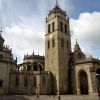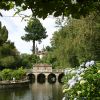Lugo. Cité Romaine
Durée: Excursion d’une journée complète
Itinéraire: Lugo - Castro de Viladonga
Description: Avec plus de 2000 ans d’histoire, Lugo occupait le rang de capitale de l’assemblée juridique pendant l’époque romaine. Ses remparts déclarés Patrimoine de l’Humanité datent de l’an 14 avant J.C. Outre un périmètre de plus de 2 km, qu’il est possible de parcourir dans son intégralité, le fait qu’elle conserve entre ces murs des rues étroites traditionnelles et des places historiques surplombées de monuments dignes d’intérêt, dont la célèbre Cathédrale, sont des raisons plus que suffisantes pour justifier la visite de cette ville. A proximité de Lugo se situe le Castro de Viladonga, qui est l’un des plus complets que l’on peut visiter et qui comporte un musée didactique expliquant comment vivaient les habitants de la Galice à l’arrivée des romains. La gastronomie typique de Lugo est une autres des raisons qui justifient cette excursion.
Arrêts recommandées
Lugo-Castro Viladonga
Cité romaine par excellence, l’image de Lugo est indissolublement liée à ses remparts et à sa célèbre cuisine, préparée à base des produits de ses terres fertiles.
Lugo, avec plus de 2 000 ans d’histoire, a été la seule ville en Galice à avoir obtenu la catégorie de capitale juridictionnelle pendant la période romaine. Fondée en l’année 14 de notre ère par Paulo Fabio Maximo, ses remparts datent de la même époque. Ils ont été classés au Patrimoine Mondial de l’Humanité. De nombreuses tours circulaires défensives sont distribuées autour d’un périmètre de 2 600 m. Malgré les réformes, ces remparts constituent la meilleure enceinte fortifiée de la Péninsule et conserve toujours deux voies principales du tracé romain original : cardus et decumanus.
Sur les rives du fleuve Miño traversé par un pont romain, on conserve encore deux salles des bains thermaux de l’époque. Vous retrouverez intra-muros les rues et les places les plus significatives, ainsi que les principaux monuments dont la magnifique cathédrale, qui a le privilège d’exposer en permanence le Très Saint. C’est la raison pour laquelle Lugo est aussi dénommée, ville du Sacrement.
La construction de la cathédrale à laquelle participèrent plusieurs maîtres maçons débuta vers 1129. Ses nefs ne furent achevées qu’au XIIIe siècle. La porte Nord a un intérêt particulier pour ses magnifiques pantocrator et tympan, ce dernier représentant la dernière Cène du Christ. Ces deux joyaux sont les meilleures pièces de la sculpture romane de Lugo.
Le couvent de San Francisco, qui conserve un cloître médiéval sobre, est devenu le Musée Provincial où se trouvent d’importantes collections d’orfèvrerie retrouvées dans les castros ainsi que de peinture galicienne. L’église adjacente et celle de Santo Domingo figurent parmi les œuvres les plus importantes du gothique mendiant.
La mairie, de même que les vieilles maisons, les demeures seigneuriales et d’autres églises, complètent le patrimoine artistique de cette ville aux étroites rues paisibles où le passage du temps semble s’être arrêté.
Castro de Viladonga
Le castro de Viladonga, particulièrement important entre les IIe et le Ve siècles de notre ère, est un des plus impressionnants dans son genre. Il possède toutes les caractéristiques propres à ces villages galiciens construits dès l’Âge du fer jusqu’à une période avancée de la romanisation. Plusieurs remparts et fossés encerclent une vaste acropole ou couronne centrale où se trouvent les maisons, les enclos, les entrepôts et les bâtiments à usage communautaire.
À Viladonga, il faut également visiter le musée, exemplaire quant à son approche pédagogique, et la maquette à l’échelle qui vous aidera à comprendre comment vivaient les habitants du 'castro' il y a 2000 ans.



















